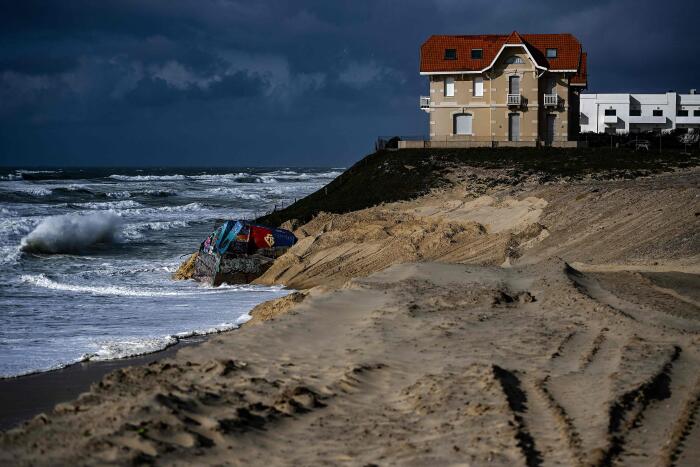An unpublished report from the Cerema analyzes the effects of rising sea levels on French coastlines, both metropolitan and overseas. While these effects are relatively modest by 2028, the erosion process accelerates by 2050 and 2100.
From cliffs to sandy beaches, the sea is encroaching on land in France. But where, and at what rate? To answer these questions, the Centre for Studies and Expertise on Risks, Environment, Mobility, and Urban Planning (Cerema), presenting itself as the public expert on the evolution of « climate and territories of tomorrow, » has conducted a prospective exercise for three timeframes: 2028, 2050, and 2100. These works, not yet officially released, provide an idea of the number of buildings that will be affected first by the inevitable retreat of the coastlines. They distinguish coastal erosion from the probabilities of marine submersion.
As the Court of Auditors pointed out in its report on France’s adaptation to climate change published on March 12, in fifty years, between 1960 and 2010, metropolitan France has already lost nearly 3,000 hectares of its coastlines. The magistrates therefore recommended establishing a diagnosis covering all French territories and taking into account the foreseeable rise in sea level. The Cerema’s work is thus timely.
By 2028, a thousand buildings are likely to be affected by coastal erosion. This includes 528 homes spread across 300 buildings, half of which are second homes. Their market value is estimated at 167 million euros. Also affected are 340 constructions in the annexes and outbuildings category, some public buildings, as well as premises housing economic activities. The inventory identified 191, including 75 beach establishments and 90 hotels, restaurants, holiday villages, evaluated at 54 million euros, as well as twenty-eight lifeguard stations, twenty-one nautical bases or surf schools, and an oyster farming facility in Morbihan.
In terms of the number of buildings affected, Corsica, Pyrénées-Atlantiques, Var, followed by Calvados, Seine-Maritime, Somme, Martinique, and Guadeloupe appear to be the most exposed. In French Guiana, 83 buildings are considered vulnerable.
Bouches-du-Rhône particularly exposed
To present its detailed methodology, Cerema mentions « a convergence of evidence » that allowed it to identify at-risk buildings within a five-meter-wide coastal strip. These are exposed constructions, not necessarily future victims of coastal erosion. The experts adopted a cautious scenario, assuming that all existing protective structures – such as dikes and rock revetments – will still be in place and « without failure » in four years. They applied to sites already affected by chronic retreat the same withdrawal rate recorded over at least fifty years.
As short-term as 2028, major storms will mainly influence the morphology of coastlines, especially sandy ones, as well as hurricanes in overseas territories. The experts incorporated this dimension of « event-driven retreat » into their scenarios for 2050 and 2100. For these works, they produced a national map of low-lying areas on maritime façades using data from the hydrographic and oceanographic service of the navy and the National Geographic Institute. They added an additional meter in height to simulate the sea level rise by 2100 as predicted by the Intergovernmental Panel on Climate Change (IPCC).
Medium and long-term impacts of erosion multiply compared to 2028. According to Cerema’s projections, nearly 8,000 hectares will be affected by 2050, including 1,000 overseas. Overall, 760 hectares of urban areas and 6,300 hectares of forests, natural areas, and agricultural land will then be affected. Then, by 2100, the retreat of the coastline reaches 506,200 hectares, including 41,200 hectares of urban areas. The anticipated losses of forest or agricultural landscape area are staggering in Bouches-du-Rhône (84,200 hectares), French Guiana (65,900 hectares), as well as Charente-Maritime (48,700 hectares), exceeding 21,000 hectares in Gironde, Gard, and Manche. Roads cut off One hundred public and semi-public buildings potentially affected multiply by a hundred between 2050 and 2100.
As for the number of homes affected by flooding, it stands at 5,200 in 2050, before climbing to nearly 450,000 fifty years later. In the same timeframe, fifty times more second homes could be affected, rising from 2,000 to over 100,000. The rapporteurs also identified 1,400 activity premises vulnerable in the medium term: offices, mostly shops (620), 117 hotels, a hundred campsites, fifteen of which could lose more than 10% of their area as early as 2050. By the end of the century, ten times more hotels would be exposed. Ten times more campsites as well: the departments of Vendée, Charente-Maritime, and Hérault could each have about a hundred affected. In total, over 53,100 activity premises could suffer from coastal erosion. The dimension of costs deserves to be emphasized.
From 1 billion euros in 2050, the estimated market value of affected homes rises to approximately 86 billion by the end of this century (55.5 billion for main residences). As for the value of activity premises, it increases from 120 billion euros to nearly 7,500 billion. Finally, coastlines may see the disappearance, initially, of 15.5 kilometers of major roads, cut off in many sections, then 1,765 kilometers, along with 243 kilometers of railways by 2100. « Compromises to be found » The experts claim to have favored « a realistic scenario. » Their projections on upcoming movements of the coastline use aerial photographs from the 2010s. Updates are ongoing. They should provide a new assessment of coastal erosion in France by the end of the year. Gonéri Le Cozannet, climate expert at the Geological and Mining Research Bureau (BRGM) and co-author within the IPCC, considers this work « interesting. » « Of course, the chosen spatial scale cannot be as precise as a local study, but this report presents an extrapolation of trends that is logical. »
According to him, the assumption of a storm causing a coastline retreat of ten meters is plausible during this century. In 2010, Xynthia had pushed the coast back by twenty meters. How will decision-makers now take hold of this data? Will they choose to add protective structures? To relocate residents? « In any case, these are subjects that must be discussed now, as compromises will inevitably have to be found, » concludes Gonéri Le Cozannet. Indeed, public authorities are beginning to react. In 2022, 126 French cities thus registered on the official list of the most exposed municipalities « to hydrosedimentary phenomena leading to coastal erosion, » which obliges them to adapt their planning and urban development policies.
A year later, 242 undertook the same approach, listed by the decree of July 31, 2023. For its part, the National Coastal Zone Committee met on February 28. Its members began addressing the challenging issue of financing erosion control and supporting affected property owners. This reflection is also fueled by the Inspectorate General of the Environment and Sustainable Development, which has just published,



